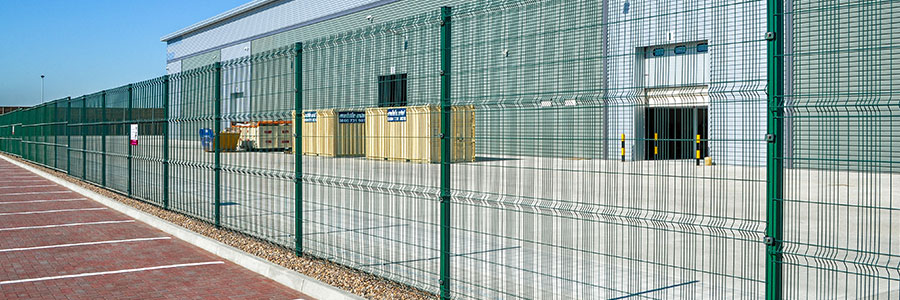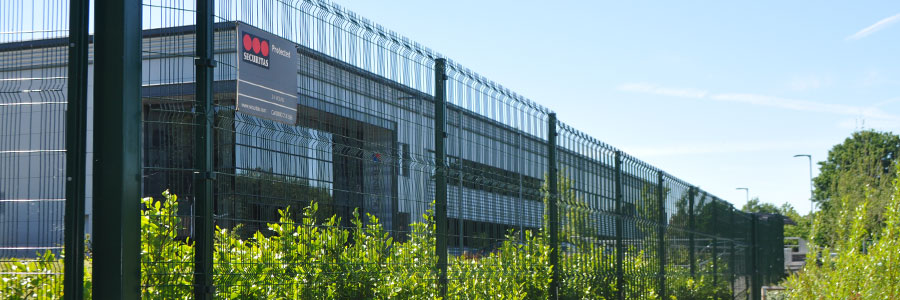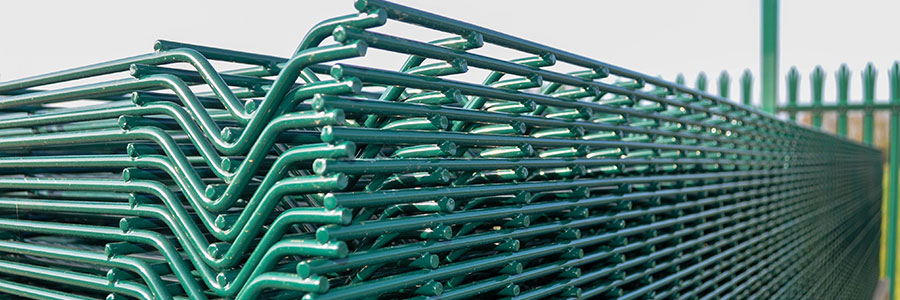Published:
Tracing the Origins of ‘Paladin Fencing: From Brand Name to UK Industry Standard
In the UK security fencing sector, you may have noticed the term “Paladin Fencing” everywhere. End-users, consultants and specifiers all commonly use the term to refer to any type of mesh security fencing, but it has not always been like this.
Its journey began with the introduction of weld-mesh fencing in Europe during the mid to late 20th century. Originally, Paladin was a brand that led the way in making this type of fencing more accessible and popular.
Traditional Paladin Fencing was recognisable by it’s ‘striped’ design, where the wires in the mesh where group together tightly, with larger spaces between groups, creating an effect that diminished the overall visibility of the fence panel, combined with crimped ‘V’s’ in the panel, this system provided strength and security. This type of mesh soon became popular across Europe, and the name Paladin became more than just it’s brand-specific roots.
Just like how ‘Hoover’ is commonly used to refer to all vacuum cleaners, Paladin has become a default term to describe all types of weld-mesh security fencing. This blog aims to explore this journey, as well as highlighting the importance of correct terminology in the industry, especially when helping clients and architects specify security fencing products accurately.
The Birth of Paladin Fencing
As weld-mesh fencing started gaining in popularity, and moving from strictly industrial uses to more commercial and residential applications, a design that provided an attractive aesthetic but still provided the same level of anti-climb protection and security was needed.
Bakaert, a Belgian steel wire fencing manufacture was the first to introduce this type of fencing, under the brand name ‘Paladin’. It soon became known for its practical and attractive design, making it a popular choice for securing public buildings, schools, car parks, business parks, industrial buildings, sports complexes, police stations, and secure units. It also became to be used in domestic gardens where perimeter security is important but visibility of the natural surroundings was desired.
Soon, other manufacturers began to copy this design, under their own brand names. With numerous different names in the market for the same style of panel, ‘Paladin’ or ‘Paladin Fencing’ started to become the default name for this style of fencing, no matter the manufacturer.
The Characteristics of Original Paladin Fencing
It’s important to note that original Paladin Fencing is a demarcation fence system. Although it features extra strength from it’s ‘V’ folds, which give it additional anti-climb properties, the single-wire design still means the panel is susceptible to cutting through the wires with basic tools. The main benefit of original paladin fencing was the striped design which caused it to better blend in with the background than other types of weld-mesh fencing of the time.
For applications that valued aesthetics over security, this was an ideal type of fencing system. It became popular around schools, playgrounds and public areas, as it was less noticeable and did not look like a traditional security fence, especially when powder-coated in bright colours.
The Evolution of Paladin towards other Mesh Fencing
As weld-mesh fencing started to become standard as the go-to security and perimeter demarcation fencing in the UK, more and more different brand names entered the market. To simplify terms when referring to this type of fencing, Paladin started to become a term for any of these varieties of mesh fencing, without the specifics of what made each system different from each other, from varying mesh gauges, sizes, security levels and standards.
This generalisation in naming can lead to confusion as to which product is being referred to. Over time, traditional Paladin fencing with it’s striped design has become less common, with standard V-Mesh, with it’s uniformly spaced single-wire design becoming the industry standard for demarcation fencing. This can be put down to the extra cost of producing traditional Paladin panels with extra machining time for the differently spaced wires.
Even though V-Mesh has surpassed Paladin as the standard type of weld-mesh fence, the term Paladin still remains. End-users, consultants and architects still commonly use the term to refer to any type of weld-mesh fence. This can lead to confusion with manufacturers who offer a striped ‘Paladin’ style panel as well as a ‘V-Mesh’ style panel, to which type of mesh the project refers to.
Implications for the Industry and Architects
For architects and specifiers, the ambiguity introduced by using “paladin” as a blanket term can result in miscommunication and mismatches between specified and delivered products. A fencing sub-contractor may interpret a fencing system specified as ‘Paladin’ as being the ‘striped’ traditional style of fencing, where the architect or client may be referring to another form of weld-mesh fencing.
It is particularly important when considering the level of security required on the specification. A fencing system around a Data Centre for example, labelled as ‘Paladin’, if installed as the literal meaning, would not be suitable for purpose. In this example, a high-security fencing system that is rated to provide intruder protection for a specific time period (LPCB approved) would be the type of system required. If a sub-contractor followed the literal meaning, and installed the demarcation version of Paladin fencing, would they be wrong, or could they say they were just following the specification?
In the education sector, especially for security and demarcation fencing, government guidance provides detailed specifications on the appropriate types and characteristics of fencing. Using the term “Paladin fencing” on drawings could lead to significant deviations from the required specifications if interpreted literally.
Less ambiguity in specifications helps the industry and the client as a whole. Presently, the range of mesh fencing from the main manufactures in the UK is comprehensive, which each system being developed for a particular application, budget and level of security. Terminology should be used that meets the level of security required for the specification. A good example is the following:
- Demarcation fencing with minimal security needed – ‘Single-Wire Weld-Mesh or V-Mesh Fencing’
- Security fencing without needing a minimum intruder delay time – Twin-Wire or Prison Mesh Fencing’
- Security fencing with a minimum intruder delay time – SR or Security Rated Mesh Fencing (and include the rating number e.g. SR2)
When specifying mesh-fencing, the risk assessment or consultant recommendation should clearly define the level of security a perimeter needs. Manufacturer CPD’s are a great source of educational material for specifiers looking to learn more about the specifics of security fencing types. Manufacturer websites also contain detailed product data sheets that can show the right applications for the specific type of fencing. If in doubt, manufacturers should be consulted directly when drawing up plans where the level of security provided by certain types of fencing is unknown. This will benefit the industry as a whole, and help move away from Paladin being the default term for all types of security fencing.
Paladin – From Specific to Generic and Back Again
While the original Paladin fencing set a high benchmark for quality and performance, the subsequent generalization of the term has introduced complexities that can impact both manufacturers and architects. As the market evolves, it becomes increasingly essential for industry professionals to embrace specificity and clarity in their terminology. By using precise language when discussing security fencing options, architects can ensure that they specify the right products for their projects, thereby enhancing safety and reliability. This commitment to accurate communication not only honours the legacy of Paladin fencing but also supports the continued advancement of security fencing solutions in a competitive marketplace.










